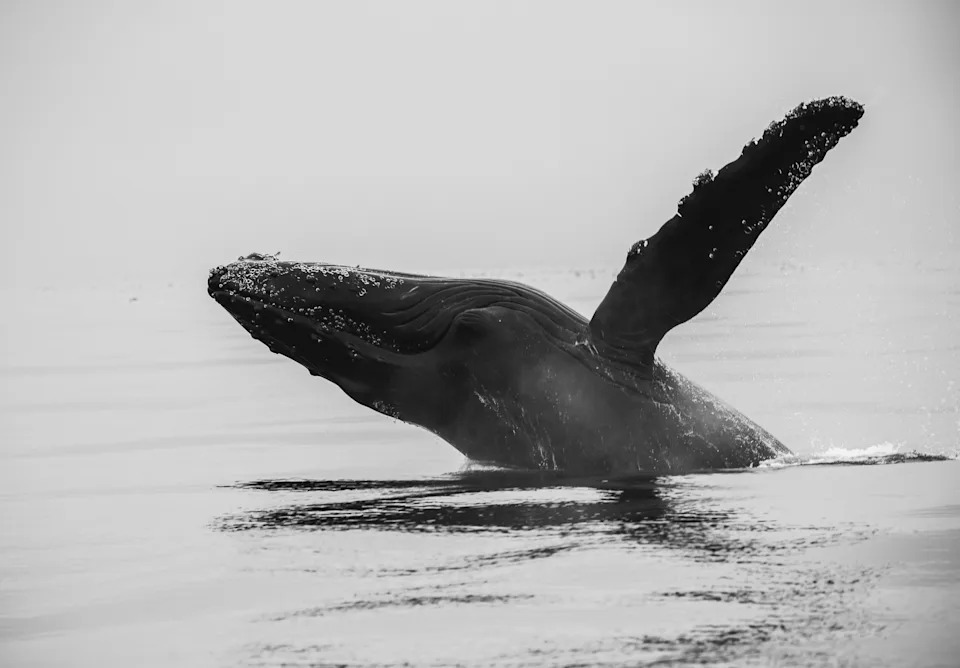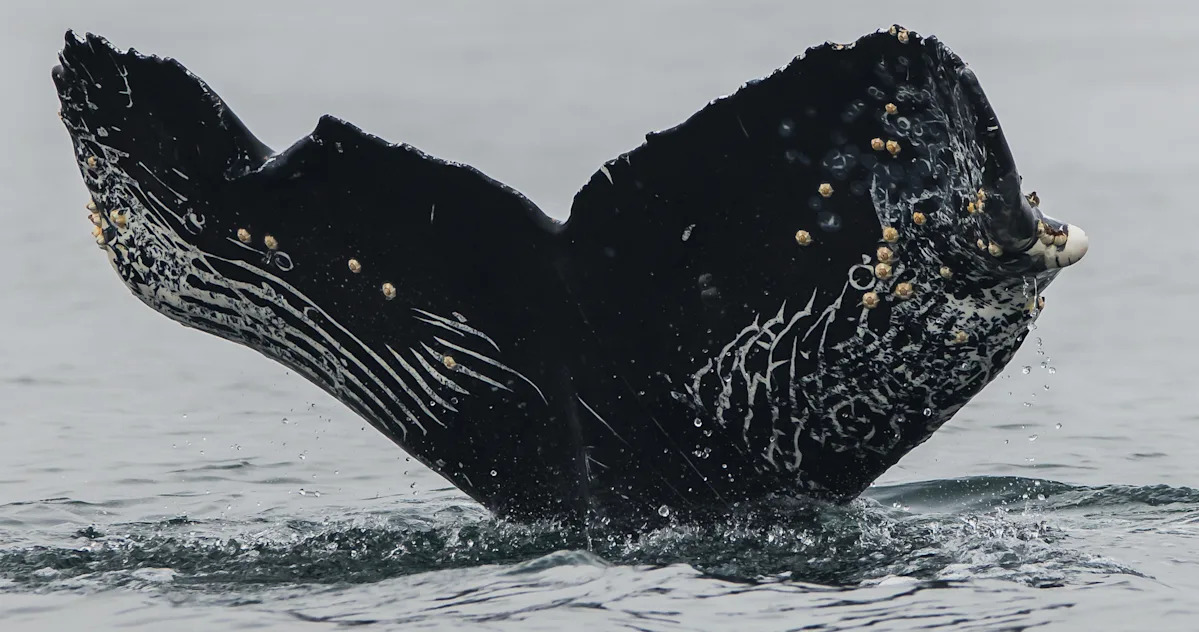In Antarctic waters, glaciers calve like distant thunder and the air stings with salt and cold. It is in these waters that marine mammal ecologist Ari Friedlaender shuts off the inflatable boat’s engine and waits. This is the edge of the world—remote, hostile, and stunningly alive. Beneath the hull, the dark sea churns with wonder abound. A humpback whale (Megaptera novaeangliae) emerges, slow, deliberate, and gentle in its curious demeanor, casting a ripple across the surface. Then another shadow glides below. One rolls sideways to peer up, one spyhops, another nudges the rubber boat as if asking a question.
“You feel alien out there,” Friedlaender tells Popular Science. “And yet, the whale chooses you and interacts with you as a curious individual. It gives you its attention, and that kind of moment is just the most compelling.”
In the last two decades, humpback whales in Antarctic waters have staged one of the most remarkable recoveries since the end of commercial whaling.
“We started seeing them again—first almost none, then a few, then many,” Ted Cheeseman, a marine ecologist and co-founder of the whale tracking platform Happywhale, tells Popular Science. “But we didn’t know who we were seeing. We wanted to know more than just that whales were coming back. We wanted to know which whales.”
[ Related: Humpback whales use bubble-nets as ‘tools’. ]
Unlike critically endangered species like the North Atlantic right whale (Eubalaena glacialis) or Rice’s whale (Balaenoptera ricei), humpbacks have shown a striking degree of behavioral flexibility and resilience in a rapidly changing ocean. But their future is still uncertain: ship strikes, warming waters, and shifting food webs continue to pose serious threats.
So began a transformative shift in whale science, driven by photography, artificial intelligence, public participation, and lab research–and it all starts with the fluke.
The story flukes tell
To the casual observer or the untrained eye, the emergence of a whale’s tail may just be an exciting and fleeting splash of black and white. But to researchers and other whale lovers across the globe, that exhilarating splash holds a unique story and is as idiosyncratic as a human fingerprint. The shape of the trailing edge, pigmentation patterns, rake marks from orca attacks, scars from fishing gear, and barnacle clusters all combine to tell the narrative of an individual whale’s life, as well as how to identify that humpback.
“Flukes as a primary piece of data are incredibly valuable,” Friedlaender explains. “They help us trace migration routes, understand site fidelity, and even track how changes in the environment impact individual behavior over time.”
Marine mammal ecologist Ari Friedlaender. Image: Avery Schuyler Nunn for Popular Science
If you’re lucky enough to observe a whale fluke arcing above the waterline, try taking a closer look beyond the marvel of it. Is the edge smooth or torn? Are there specks, scars, or barnacles dotting one side more than the other? Do the pigmentation patterns differ from other fluke’s that you’ve spotted? Like a fingerprint, these ever-so-slight irregularities and subtle signatures mark a whale’s identity, and can give you some insight into their life story.
This citizen science and fluke analysis is crucial, because whales are famously hard to study. As Cheeseman puts it, “We see one percent of a whale for one percent of its life.” Most of what whales do—feed, rest, nurse, socialize—happens deep below the surface, and far from view. That disconnect, he says, contributes to a larger issue: a failure to relate.
“When we look out at the horizon,” he says, “we’re removed from what’s really happening under the waves.”
Whales need you–to take photos
Happywhale aims to change that by making individual whales visible, trackable, and, most of all, relatable. Anyone—tourists, sailors, researchers—can upload a fluke photo to the platform. AI, trained on thousands of images, scans each photo and compares it to over 112,000 known whales in the database.
“The algorithm reads features we might miss,” Cheeseman says. “Even if a scar disappears, or pigmentation changes over time, the trailing edge often stays consistent from nearly birth. The computer can pick up on that and match individuals with more accuracy than the human eye.”
Still, every match is verified by a human—preserving both the integrity of the data and the intimacy of the process. “The goal is to keep people at the center of the science,” Cheeseman says. “We want people to feel close to it.”
And they do. When someone uploads a photo and later receives a notification that “their whale” has been seen thousands of miles away, something shifts. “It lights something up inside people,” he says. “They go from being a bystander to being part of a story.”
That story is often one of resilience in a rapidly changing ocean. Many whales carry visible signs of survival—scars from boat strikes, or entanglement wounds that wrap around the tail like old rope. In 2016, there were 71 documented whale entanglements off the US West Coast, but Cheeseman estimates that’s just 10% of what actually occurred.
“Imagine driving down a road and seeing a deer caught in a barbed wire fence,” he says. “Most people would stop, call someone, and maybe even risk yourself to help free it. But with whales, it’s out of sight, so it’s out of mind, and since we don’t know about it, we don’t care, and we don’t act.”
The work Friedlaender and Cheeseman are doing—alongside the growing community of citizen scientists—aims to help close that gap. And in a time when climate change, noise pollution, and industrial fishing continue to erode ocean health, proximity matters.
“We’ve urbanized the ocean,” Cheeseman says. “We build roads in it—shipping lanes—and infrastructure like ports and offshore platforms. We ask so much of it. But we don’t think of it as part of our shared space.”
That’s beginning to change, and in part, it’s because of whales. Not just whales as a species, but whales as individuals.
Early whale research looked at the species as a whole, Friedlander notes, but fluke matching has transformed this approach by allowing scientists to study individual whales in much finer detail. This method opens up opportunities to investigate how specific factors—such as food supply, noise pollution, or environmental shifts—affect particular whales and various demographic groups differently.
“What has really been valuable,” he continues, “is being able to say, ‘This is a fluke of an individual whale with a long sighting history—41 years in one case.’ When you want to study processes that happen over an animal’s lifetime, that contextual detail becomes crucial.” This rich, individual-level perspective informs everything from behavioral studies to toxicology research, facilitating new ways in understanding these ocean giants in unprecedented depth.

A playful juvenile breaches the water. Image: Avery Schuyler Nunn for Popular Science
‘That personal connection leads to a desire for protection’
Friedlaender’s research focuses on detailed snapshots of individual whales using suction cup tags that collect incredibly fine-resolution data. These tags reveal intimate details about how a whale moves, dives, and feeds—showing, for example, how it manages to engulf what’s essentially a swimming pool’s worth of water in a single mouthful to fuel its massive energy needs.
Cheeseman highlights how this complementary blending of citizen science and traditional scientific methods brings research from being something “out there” to something closer and more accessible.
“By combining fine-scale data from suction cup tags with long-term sighting records collected by everyday people through Happywhale, we create a more holistic view of humpback whales—connecting detailed individual behaviors to broader lifetime patterns and population trends.”
[ Related: Whale pee moves vital nutrients thousands of miles. ]
And it all stirs something deeper. “We are wired to care about individuals more than abstract concepts,” Cheeseman continues. “And that personal connection is what leads to a desire for protection.”
Friedlaender and Cheeseman will soon return to Antarctica to continue their research in one of the planet’s most ecologically vital and least accessible regions. Their work is supported through a partnership between the Friedlaender Lab at the University of California, Santa Cruz, and Quark Expeditions, which facilitates science-based voyages in the Southern Ocean. In these former whaling grounds, the team will deepen their data on humpback behavior and migration—bringing AI, photo ID, and public participation into one of the last truly wild frontiers.
One whale at a time, the ocean is becoming less anonymous. And with every scar and splash recorded, the researchers see that a clearer picture of this hidden world begins to emerge, not just in the minds of scientists, but in the hearts of the people observing, and participating, from ashore.
